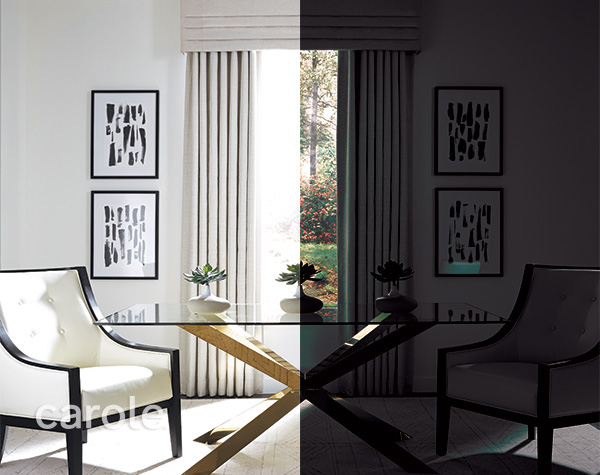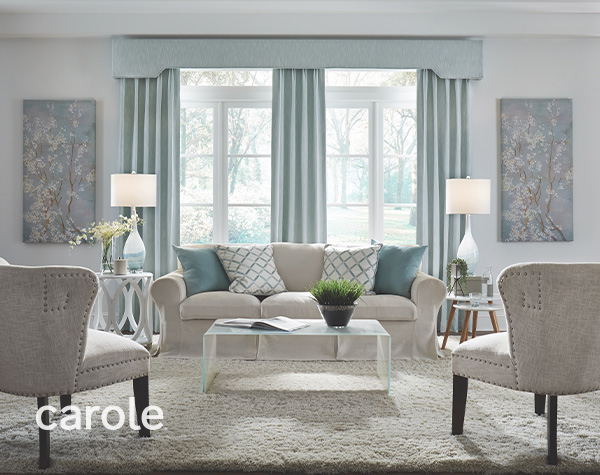
Photographing Window Treatments
May 17, 2021
5 Ways To Make a Room Feel Bigger
August 2, 2021When I was selling window treatments as a designer, I am happy to say I was very successful at it. I know I wasn't the best because there are always better designers. But my selling approach was about people first, then about design. I never wanted anyone to walk into a house that I had decorated and know that I had done it. I wanted them to walk in and tell my client that the design was perfect for them!
This approach led to great designs, happy customers, great referrals and many new friends that I still have today. And it all starts with the design appointment!

1. Preparing for the Appointment
Preparing for the appointment begins before you even have the appointment. Do your research!
Ask yourself these questions:
- Where is my customer shopping?
- When they research draperies, what are they seeing online?
- What do the retail stores in their area offer?
- How much do draperies cost at those stores?
Understanding what kind of information your customer is gathering helps you determine how to educate them on the differences between custom drapery and ready-made products.
As you visit stores in your area or shop online, notice the differences between those products and custom products from Carole Fabrics. Use the chart below to note some of the differences.
| Custom with Carole | Ready-Made |
|---|---|
| Stable Headings Through Use of Buckram | No Structure |
| Custom Returns | No Returns |
| Hidden Stitching | Exposed Stitching on Headers and Hems |
| Pattern Matching | No Pattern Matching |
| Custom Widths and Lengths | Single Widths at 84", 96" or 108" Lengths |
| Panel Lengths Aligned | Varying Separate Panel Lengths |
| Thousands of Fabric Choices | Limited Choices, Usually Neutrals and Solids |
| Lining Included, Custom Lining Options Available | Unlined or Fused Lining |
| Weights in Corners and Seams | No Weights |
| Style and Upgrade Options | What You See Is What You Get |
As you talk to your customer, work these differences into the conversation. If they have any ready-made treatments in their home, use those to point out the contrasts — keeping in mind that there is a place for ready-made product so the differences should be educational but not negative. The education will go a long way to help close your sale. You may want to keep some ready-made treatments in less significant areas of the client's home to free up budget for other rooms.
Tip!
When specifying lengths and widths for custom, do NOT specify sizes that are frequently bought ready-made.
- Length: Usually ready-made lengths are 84", 96" or 108". Get creative! Find the perfect length to maximize the effect of the window treatment.
- Width: A single width panel is readily available ready-made but is rarely the full width a customer desires even for a stationary panel. Go for at least a width and a half or two widths to provide that custom look of fullness.
There are a few other things I like to do prior to the appointment with a customer.
- Engage immediately with your customer by sending an email with some fabric swatch images. You can email fabric suggestions directly from Carolenet!
- An immediate connection helps keep them interested in what you can provide and not shopping elsewhere. This is critical if your appointment is more than a couple of days out.
- Search your customer's home online to get a preview of the street view, window types, and other external details. Just type in their address!

2. When You Arrive on Site
Don't park in the driveway, and be sure to tell your installer to never park in the driveway. The last thing you want is to leave a tire mark or spot on your customer's driveway. Eliminate the possibility!
Start getting to know your customer. Open your eyes and notice everything about your customer's home and style.
- Does the home have a casual or formal feel? Is it high or low maintenance?
- Is the customer using light or dark tones? Neutral or bold colors? Patterns or solids?
- Are there any signs of children or pets?
Don't assume anything! These are observations and they need to be validated through conversation.
3. Questions to Ask
A trick I learned years ago that has never failed me is simply this: I would ask my client to walk me through a typical day in the room I was designing.
"Tell me everyone who comes in here, what time of day they use the room, and what they do in here."
I guarantee you will discover what your client truly needs for this room. Once you know that, you are headed for success.
Perhaps an adult enters the room early to read the paper. The dog likes to relax in the midday sun. The kids use the room to do their homework after school. Everyone gathers in the room to watch TV at night.
Other questions you will want to ask include:
- How does their use of the room change on the weekends?
- Do they notice heat buildup in the summer or heat loss in the winter?
- Do they have any plans to change the design of the room or buy new furniture?
- Do they have any long range plans you should consider? Will they be selling or renting the home? Children or grandchildren on the way?
Listen carefully and use this information to discover their needs and identify problems to solve. You will establish different needs for privacy, light control and temperature control that you can incorporate into your design.
Doing this shows you care about how your customer lives in their home!
To help your client communicate what styles they like, show pictures from our website or the Carole Lookbook. Ask them to tell you not only what they like but what they don't like — people often find it easier to say what they don't like. Use this information to filter the products that you present. You will avoid overwhelming the customer with too many choices, which will increase the likelihood that they like your design.

4. Establishing Trust and Showing You Care
The most important thing you can do is establish trust with your client.
- Determine your client's needs and show concern for those needs.
- Verbalize and confirm the needs you have identified for your client.
- Link your design to your client's needs to show you care how they live in their home.
- Present your ideas as solutions for light control, privacy, ease of operation, maintenance, climate control, and safety for children and pets.
- Set expectations. If there is hand dressing required for their drapery or shades, tell them. If they have ordered blackout lining, tell them about light gaps. Establishing trust means telling the truth, the whole truth.
Let them know you have their back and that you care about how they live in their home. As the professional, you will recognize their needs and offer the BEST solutions. Educate them as you provide options that spend their budget wisely.
Once this is done, they will not want to buy from anyone else and budgets open up.

5. Discussing the Budget
Never assume what your client can afford! Listen to what your client says about budget but don't let that completely drive your design.
Remember, customers don't know what they don't know. Most clients have no idea what custom draperies cost. If you educate your client as you solve their problems and improve the way they live in their home, money becomes less of an issue.
Ask yourself: Have you ever spent more than you planned on something after you became educated about that product? Of course you have! You learned the value of the product and how it would improve your life, so you found the budget to make it happen.

6. Closing the Sale
Your client deserves the opportunity to buy the best. Always present the best solution and let the client decide if the budget needs to come down.
If motorized shades are the best solution for your customer, tell them. Otherwise, they may see them later at a friend's house and question your knowledge. You already missed out on that sale, now you potentially lose a client or referral. Big mistake!
It's always easier to start high then reduce the cost as needed. If the client expresses a desire to lower the cost, then address the issue — change a fabric, remove an option, or break the order into multiple sales. Every price you give after the first one will sound better if you started with the best. But if you start low, you have likely undersold the project and it is very difficult to add options after you have quoted a price.
Now it is time to provide the quote. If you are not doing the quote on site, be sure to do it very quickly.
You never want to lose a sale because it took too long to get the estimate to your client. The longer they have to wait, the more likely they are to call someone else and get another quote.
The most efficient way to create a quote is to use Carolenet. Be sure to reach out to us for sign-up information or training so you are ready to go!
And of course, don't forget to ask for the sale! If you find this difficult, just assume the sale and start talking about delivery and installation. Remind your customers that fabric stock does not last forever. If they wait, there are no guarantees that the fabric they love will still be available. You will find out very quickly what their thoughts on purchasing are!
7. Creating a Client for Life
Treat the design appointment as the beginning of a relationship. This should be your FIRST sale with this client, not the last!
Creating ongoing relationships builds your network and increases your referrals significantly. People love to talk about the next project they are planning for their home. Make sure they are talking about your ideas!
Plant the seeds for future sales by providing complete design ideas with all of the options because it might lead to more than one sale. As you walk from room to room in the house, make suggestions — get them thinking about the next great idea.
Leaving your client with their next design idea gives you a reason to call them again. Or they may call you first!
When the sale is finalized, keep your name top of mind by creating a nice leave-behind. Use Carolenet to order memo samples of the fabrics your client selected, up to 10 per day at no charge. Enclose them in a folder with a copy of the final invoice, your business card and a thank you note. This presentation will provide an ongoing reminder of you and your business.
I would describe a successful design appointment as one that not only culminates in a sale, but creates a happy customer who comes back to you again and again while referring new contacts to you along the way. Think of each customer you meet as an opportunity to build your network and make some friends.
If you're not already a Carole Fabrics customer, contact us today to open an account. Happy selling!

Susan Pfingst
National Training Coordinator
With over 35 years in the Home Design Industry, Susan brings her extensive experience in design and sales. Training is her passion and she looks forward to sharing her insight!

